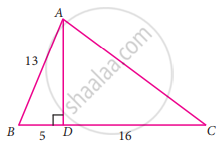Advertisements
Advertisements
प्रश्न
If A and B are acute angles such that tan A =`1/3, tan B = 1/2 and tan (A + B) =` show that `A+B = 45^0`
उत्तर
Given:
tan A = `1/3 and tan B = 1/2`
tan (A+B) = `(tan A + tan B)/(1- tan A tan B)`
On substituting these values in RHS of the expression, we get:
`(tan A + tan B )/(1- tan A tan B) = ((1/3 +1/2))/((1-1/3xx1/3)` =`((5/6))/(1-1/6) = ((5/6))/((5/6))=1`
⇒ tan (A + B) = 1= tan `45^0` [ ∵ tan 450 =1]
∴ A+B = 450
APPEARS IN
संबंधित प्रश्न
if `cos theta = 5/13` find the value of `(sin^2 theta - cos^2 theta)/(2 sin theta cos theta) = 3/5`
if `sin theta = 3/5 " evaluate " (cos theta - 1/(tan theta))/(2 cot theta)`
In ∆PQR, right-angled at Q, PQ = 3 cm and PR = 6 cm. Determine ∠P and ∠R.
Using the formula, tan 2A =`(2 tan A )/(1- tan^2 A)` find the value of tan 600, it being given that tan 300 = `1/sqrt(3)`.
In each of the following, one trigonometric ratio is given. Find the values of the other trigonometric.
cotA = `(1)/(11)`
In ΔABC, ∠A = 90°. If AB = 5 units and AC = 12 units, find: cos C
In ΔABC, ∠B = 90°. If AB = 12units and BC = 5units, find: tan A
If sinA = `(3)/(5)`, find cosA and tanA.
From the given figure, find the values of sin B
If A + B = 90°, cot B = `3/4` then tan A is equal to ______.
